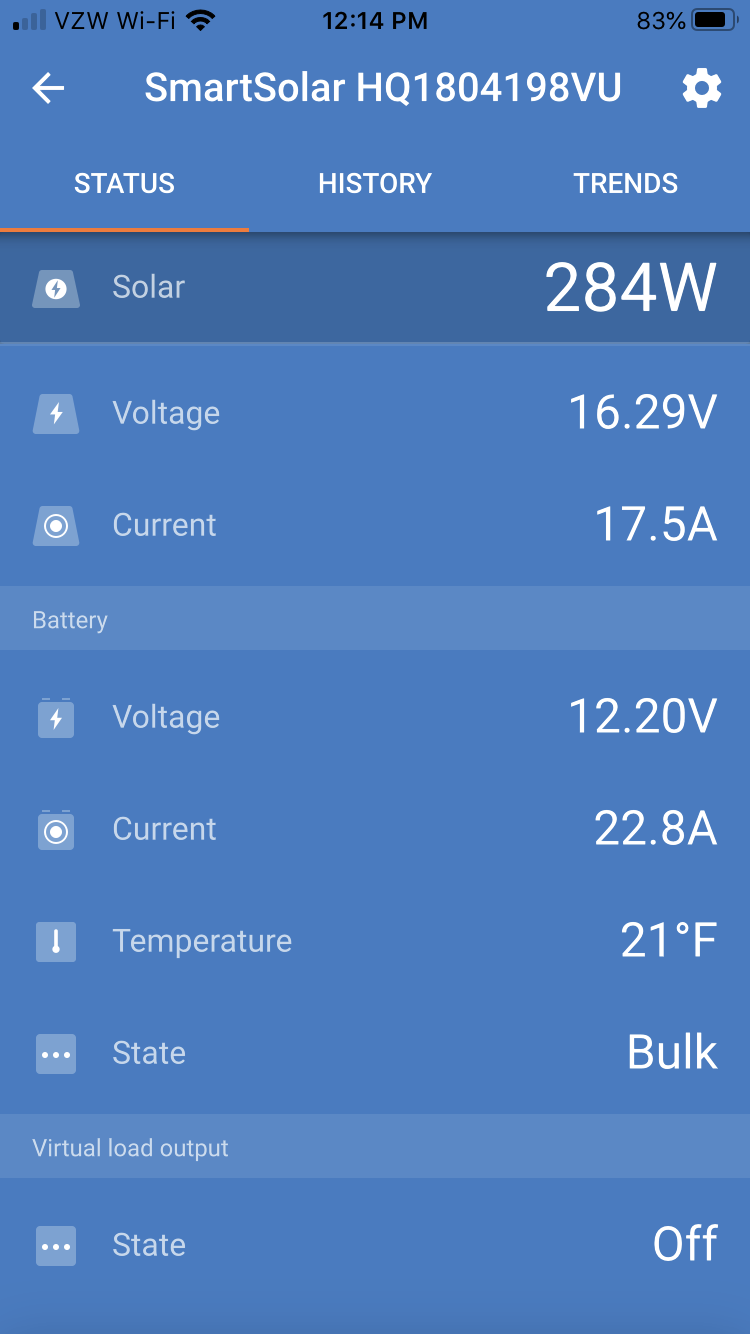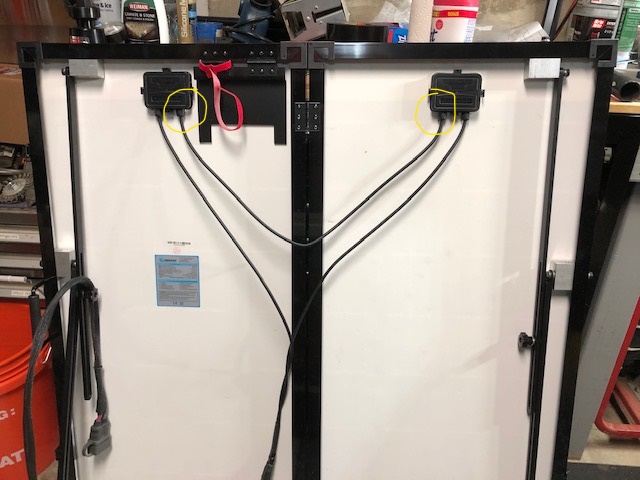 I was just testing a second suitcase I put together last week. I turned on the inverter and a small space heater on low to provide a load. I ran this test at 12:15 pm in full sun at 7500 ft altitude with no haze. I thought I would produce more watts, but something must be limiting it since I only got 260W running both 200W suitcases. I did note that the battery temperature was at 21 degrees F (using SmartSense), so maybe that is limiting the wattage the solar charger letting through. I let it run for a while and my SOC was 88%.
I was just testing a second suitcase I put together last week. I turned on the inverter and a small space heater on low to provide a load. I ran this test at 12:15 pm in full sun at 7500 ft altitude with no haze. I thought I would produce more watts, but something must be limiting it since I only got 260W running both 200W suitcases. I did note that the battery temperature was at 21 degrees F (using SmartSense), so maybe that is limiting the wattage the solar charger letting through. I let it run for a while and my SOC was 88%.
- Home
- Anonymous
- Sign in
- Create
- Spaces
- Grafana
- Node-Red
- Unsupported topics
- Questions & Answers
- Modifications
- Communauté francophone
- Deutschsprachiger Bereich
- Preguntas en Español
- Explore
- Topics
- Questions
- Ideas
- Articles
- Badges
question
400 Watt Panels only Charging 260W on MPPT 100/30
Are you sure that there was sufficient load to utilize everything the panel had to offer?
Drain your bank to 50% or put a kettle on the boil or something like that to ensure that the system is using every possible joule the panel can give it.
400Wp is the maximum you can get at perfect conditions.
You 284W are 71% of that and without knowing your installation of the panels I think that is pretty good.
You will never have 100%.
@davidpheteplace, I'd suggest checking your panels again (particularly your connections, perhaps) because your panel voltage is super low at 16.29v (in fact, if it were just waking up, the MPPT wouldn't even start charging your battery with that voltage from the panels).
What's the VOC rating of your panels? I'd expect to see closer to ~19-20v from a parallel array in the conditions that you're describing; something seems amiss.
@Justin Cook, The open voltage of one Renogy 200W solar suitcase is 21.2V. There are two connected in series/parallel. There is 25 feet of 6 gauge welding wire connecting the two suitcases to the MPPT 100/30 solar controller. The parallel connection in the cable are made with Ancor 309203 butt connectors (and I used a proper Greenlee crimper for all crimps). Can you see any issues with these components or connections. Should I run the diagnostics for each separate suitcase to compare the results (which may test if the series/parallel joiner cable is at fault)?
@davidpheteplace, when you say 25', do you mean that the suitcases are literally 25' away from the controller? If so, this might be part of the problem: 25' one-way = 50' round-trip, and your voltage drop over 6AWG wire at that distance is nearly 3% (calculating based on the ~20A @ ~16v from your screenshot).
I'm definitely surprised to see such a low voltage from the suitcases... the two panels in each suitcase must be parallel connected, not series'd. Have you tried -as another user suggested- connecting the two suitcases in series to get your voltage up? This would also help your voltage drop over that distance, as you'd be golden with 6AWG at 50' if you bumped the voltage up to ~32v and the amperage down to ~10A.
@Justin Cook. The cable is 25 feet so that I can find sunshine when needed. I have a 10 foot cable for when the sunshine can be had at the trailer.
I have run some test yesterday on powering up each suitcase separately, and then in the parallel circuit with the combiner cable. I will not put the data on here as it is just too much, but I will put a call into the Renogy tech department when they reopen on Thursday. I want to see what they think of the data I am seeing. Some of it makes sense to me and some of it does not.
One thing I am perplex by are the panels in each suitcase and how they are hooked up. They clearly look like a series connection when I look at them. When I look at the electrical specs for each 100W panel, the operating spec for each panel is 17.7V and 5.68A. When I look at the specs for the 200W suitcase, however, the operating voltage/amperage is 17.7V and 10.35 A. That would clearly indicate a parallel connection. I am hoping Renogy can explain this.
Thanks for your help (and to everyone else who has responded). I'll let you know what they say.
@davidpheteplace, it would certainly make sense for them to be in a series connection... but that being said, I'm not surprised if they aren't.
Good luck with Renogy! They're a branding company, not a manufacturer, so my overwhelming experience with their tech support has been that no one particularly knows any of the real specs of their products because they neither manufactured nor designed them... but I've got my fingers crossed that you get someone knowledgeable!
@Justin Cook. @JohnC. @warwick. So the mystery is resolved. I called Renogy tech support this morning and he explained why I was seeing what I saw.
This is the simplified explanation he gave me. The Renogy Eclipse 100W panels have the solar cells hooked up in parallel internally, hence the higher amperage. The two panels in the suitcase are hooked up in series, hence the amperage is doubled. The results of two suitcases hooked in parallel would be an operating voltage of 17.7V and the operating amperage about 20.8A. If you consider this was through 25 feet of cable, a space heater running on the inverter and a relatively full battery, my results of 16.29V and 17.5A is about what he would expect. The 22.8A on the battery he believes are the limit my batteries can except given the high SOC of 88%.
I am letting my batteries SOC gradually go down and I will retest when the get to 75%.
Thank you for everyone help.
@davidpheteplace herrrrrmmmmm except that if the panels are truly connected in series, the voltage doubles, not the amperage. Parallel=current additive (amperage), series=voltage additive. If each panel is ~17.7v and 5.68A, connecting two panels in series would = ~35.4v and 5.68A. Two panels in parallel would equal ~17.7v and 11.36A. Your screenshots show V/A measurements that are appropriate for the panels being parallel connected, not series. So... hate to say it, but if that's really what Renogy told you, I'm afraid they may be blowing smoke where the sun don't shine :-P
@Justin Cook. I know what series and parallel connection are and do. That is why this is so confusing. In the attached picture, you can clearly see that the factory wiring is in series for the suitcase. I circled the terminals in yellow. The positive lead from the left panel goes to the negative lead in the right panel, yet the electrical results are a parallel connection of the two 100W panels. The other suitcase is exactly the same. The parallel connection of the two suitcases gives the results you would expect. He may have been blowing smoke somewhere, but I have no other explanation than what he gave me for the electrical results. Do you (or any of you)??

@davidpheteplace how freaking odd. Well... I guess my only explanation is that their "21.2 VOC" rating for these panels is for both panels together... meaning each 100w panels is, what, 10.6VOC or thereabouts.
That's incredibly odd to me, just like... why... why would they do that...
Hi David.
I looked up those panels on the Renogy website, and the specs show just 183W rather than 200W. That would disappoint me straight off.
Your wires are overkill if anything, and provided no jointing issues, should be fine.
You could also try wiring the panels in series to see if that helps (higher V, lower A). Might help lengthen your solar day at dawn & dusk anyway.
Your mppt seems to be tracking the Vmpp ok, but it's lower than the spec sheet. Might be the low temp, but I've no experience there.
@JohnC. Hi john. I am curious where you are seeing 183W on Renogy for this suitcase? These are Eclipse 100W panels. For the suitcase, I only see 200W in the spec sheets on the web site.
I think I may have figured out part of the problem. When I started this test, the battery SOC was near 99%, so the battery voltage was over 12.6V. The solar charger reads the initial voltage to determine the absorption time. At 12.6V+, it reduces the absorption time by 1/6 to one hour. Maybe that is what is limiting the solar through-put to 284W at 16.29V??
The W isn't stated directly, but if you multiply out the 'optimum' V and A they spec you get 183W. That's how it works, and normally makers simply show Vmp and Imp for those. Maybe they're fudging somehow, or a print error? But something's not right..
Your solar output won't be throttled by Vbat until Abs level is reached. In Bulk state the charger is giving it's all, unless you have a 'Battery Safe' mode checked, and it's limiting the rate of V rise. If you have that, try a simpler algorithm to test it.
Go by Justin's wire suggestions, he worked it out, while I just guessed..
Related Resources
Additional resources still need to be added for this topic
question details
14 People are following this question.
